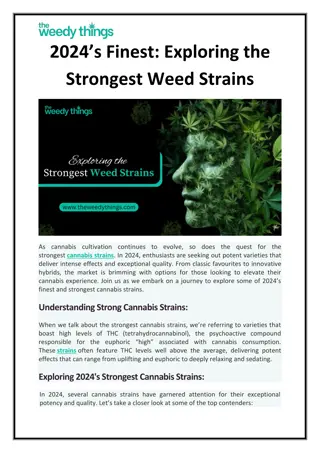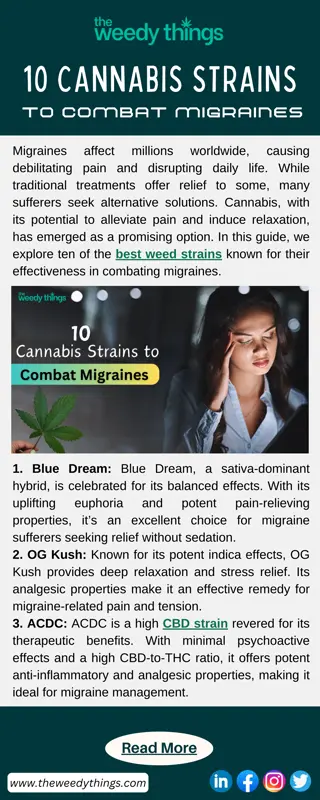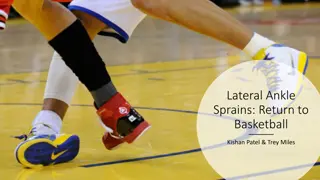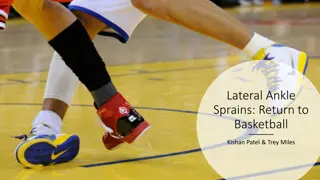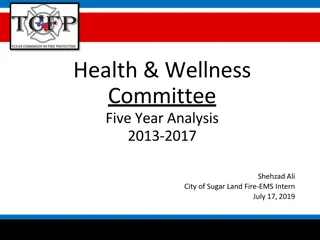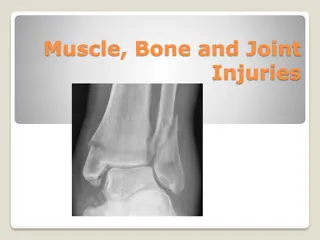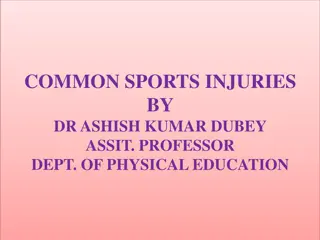Understanding Sprains and Strains: Prevention and Statistics
Sprains and strains are common workplace injuries that can be avoided through proper habits and awareness of personal health factors. This article explores the causes, statistics, and prevention strategies for these injuries, emphasizing the importance of avoiding excessive force, awkward positions, and poor health habits. By understanding these factors, individuals can protect themselves from the risks associated with sprains and strains.
Download Presentation

Please find below an Image/Link to download the presentation.
The content on the website is provided AS IS for your information and personal use only. It may not be sold, licensed, or shared on other websites without obtaining consent from the author. Download presentation by click this link. If you encounter any issues during the download, it is possible that the publisher has removed the file from their server.
E N D
Presentation Transcript
Sprains and Strains How I respected by body and helped avoid injury.
What is a sprain or strain? What is a sprain or strain? According to the Mayo Clinic, A sprain is a stretching or tearing of ligaments- the tough bands that connect two bones together in your joints. The most common place for a sprain to occur is in the ankle. (Sprains - Symptoms and Causes, 2020) A sprain is an injury to a muscle or tendon the fibrous tissue that connects muscles to bones. Strains commonly occur in the lower back and in the back of the thigh (Muscle Strains - Symptoms and Causes, 2020).
Statistics on Sprains & Strains According to the U.S. Bureau of Labor Statistics the nonfatal injury with the highest incident rate to occur in the workplace Sprains, Strains, and Tears. (Type of Injury or Illness and Body Parts Affected by Nonfatal Injuries and Illnesses in 2014 : The Economics Daily: U.S. Bureau of Labor Statistics, 2015) With sprains and strains being as common as they are over $30,000 is spent on workers compensation with sprain and strain as both the cause of injury and the nature of.
Construction (195,600 workplace injuries and 3,600 workplace illnesses) Overexertion and bodily reaction (approximately 33 incidents per 10,000 full-time workers) Sprains, strains, and tears (approximately 35 incidents per 10,000 full-time workers) Sprains, strains, and tears (median of 11 days) 6th most common Non-fatal workplace injury is sprains and strains (Workplace injury statistics-2019)
How do these injuries occur? Habits to avoid: Sprains and strains are not just something that occurs in the workplace. Personal health is an important consideration when considering the reasons for an injury. Strains and sprains related to lifting and material handling are some of the most frequent types of injuries, both on and off the job. While some factors that contribute to the potential for injury cannot be controlled, others can be reduced or minimized. Poor physical fitness, obesity, smoking, poor posture, and medical/physical deficiencies are personal factors that may contribute to strains and sprains (Strain & Sprain Prevention, n.d.) Use of excessive force. Excessive repetitions of a task. Working in an awkward position. Working in poor environmental conditions. Working while fatigued or with lack of rest. Poor health habits such as smoking or being overweight. Ignoring early signs and symptoms.
What causes sprains and strains in the workplace? Excessive force on muscle that would lead to fatigue Excessive repetition Working in awkward positions puts stress on the joints and muscles Trying to recover from a trip or slip(https://ergo-plus.com/prevent-sprains- strains-workplace) This Photo by Unknown Author is licensed under CC BY-NC
What measure can we take to prevent sprains and strains? Keeping oneself in shape overall Good dietary habits Stretching prior to work and during the shift Company sponsored per-work exercise program(https://www.wcf.com/strains-and-sprains-prevention)
S.M.A.R.T. Lifting Technique Size up the load Assess the size, weight, and shape. Remove obstacles from the load (such as loose wrapping materials). Assess whether the load actually needs to be moved Where is the load going to be placed? Remove obstacles from your path. Determine whether mechanical or assistance from a co-worker is required Move the load as close to your body as possible Stay close throughout the lift The whole hand should be used to ensure a firm grip Always bend your knees Maintain balance Keep feet apart and in a comfortable position Minimize bending at the waist Bend your knees to a semi squat Raise the load with your legs Lift smoothly, without jerking Maintain the normal curve of your spine throughout the lift Tighten the abdominal muscles and exhale while lifting Turn your feet in the direction that you want to move the load Avoid unnecessary bending, twisting, and reaching Change direction by turning your feet and not your back(http://hfairall.weebly.com/smart-lifting.html)
Team Lifting Team lifts are appropriate if: The load is too heavy for one person The load is large, bulky, or oddly-shaped You feel uncomfortable lifting the load by yourself (and do not have the proper equipment) Plan the lift Lift and lower in the same manner Move slowly and evenly Keep the load level and the weight evenly distributed. Team Lifting No-No s Twist their bodies when lifting or carrying, Lift from one knee, Change their grip while holding the load, or Step over objects when moving the load.(https://ehsdailyadvisor.blr.com/2009/12/team- lifting-a-special-case-with-special-rules/)
Sprains and Strains Symptoms You Should Know Astrain is defined as an injury to a tendon (tissues that connect your muscles and bones) or muscle. Strains can range from mild to extreme; and may mean your tendon or muscle has a partial or complete tear. A sprain is a stretching or tearing of ligaments the tough bands of fibrous tissue that connect two bones together in your joints. The most common location for a sprain is in your ankle. Common symptoms of sprains Common symptoms of sprains Common symptoms of strains Common symptoms of strains bruising pain around the affected joint swelling limited flexibility difficulty using the joint s full range of motion muscle spasm pain around the affected joint swelling limited flexibility difficulty using the joint s full range of motion
References https://www.mayoclinic.org/diseases-conditions/sprains/symptoms-causes/syc-20377938 Sprains. (2020, September 25). Retrieved November 06, 2020, from https://www.mayoclinic.org/diseases-conditions/muscle-strains/symptoms-causes/syc-20450507 Muscle strains. (2020, September 01). Retrieved November 06, 2020, from https://www.mayoclinic.org/diseases-conditions/muscle-strains/symptoms-causes/syc-20450507 VIDEO - Muscle strains - Symptoms and causes. (2020, September 1). Mayo Clinic. Economics Daily: U.S. Bureau of Labor Statistics. (2015, December 2). Https://Www.Bls.Gov/. https://www.bls.gov/opub/ted/2015/type-of-injury-or-illness-and-body-parts-affected-by-nonfatal- injuries-and-illnesses-in-2014.htm Type of injury or illness and body parts affected by nonfatal injuries and illnesses in 2014 : The https://injuryfacts.nsc.org/work/costs/workers-compensation-costs/ Workers compensation costs by cause, 2017 - 2018. (n.d.). [Graph]. Injury Facts.
References Contd from https://workinjurysource.com/workplace-injury-statistics-2019/ J fabian. (2020, September 26). Workplace Injury Statistics - 2019. Retrieved October 25, 2020, from https://workinjurysource.com/workplace-injury-statistics-2019/ J fabian. (2020, September 26). Workplace Injury Statistics - 2019. Retrieved October 25, 2020, SHRM. https://www.shrm.org/resourcesandtools/hr-topics/risk-management/pages/prevent-sprains- strains-workplace.aspx Middlesworth, M. (2019, August 16). How to Prevent Sprains and Strains in the Workplace. Retrieved October 26, 2020, from https://ergo-plus.com/prevent-sprains-strains-workplace/ Middlesworth, M. (2014, February 05). How to Prevent Sprains and Strains in the Workplace. https://www.wcf.com/strains-and-sprains-prevention Strains and Sprains Prevention. (n.d.). Retrieved October 27, 2020, from
References Contd SMART lifting. (n.d.). Retrieved October 28, 2020, from http://hfairall.weebly.com/smart-lifting.html October 28, 2020, from https://ehsdailyadvisor.blr.com/2009/12/team-lifting-a-special-case-with-special-rules/ Kilbourne, C. (2009, December 29). Team Lifting: A Special Case with Special Rules. Retrieved conditions/sprains/symptoms-causes/syc-20377938 Sprains. (2020, September 25). Retrieved October 25, 2020, from https://www.mayoclinic.org/diseases- from https://www.osgpc.com/what-is-a-strain-injury/ (2019, June 27). What is a Strain Injury?: Orthopedics Doctor Fairfield. Retrieved October 25, 2020, from https://www.healthline.com/health/sprain-vs-strain Holland, K. (2017, March 20). Sprain vs. Strain: What's the Difference? Retrieved October 25, 2020,




